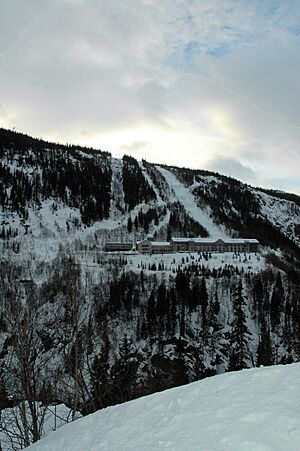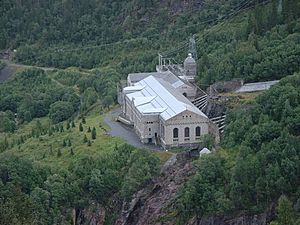Operation Freshman facts for kids
Quick facts for kids Operation Freshman |
|
|---|---|
| Part of the Second World War | |
| Rjukan_-_no-nb_digifoto_20160511_00012_NB_MIT_FNR_04361 (cropped).jpg The Vemork hydroelectric plant, circa 1947. |
|
| Type | Sabotage |
| Location | Telemark, Norway |
| Planned by | Combined Operations Headquarters SOE |
| Objective | Destroy German heavy water production at Vemork |
| Date | 19 November 1942 |
| Executed by | 34 glider borne commandos |
| Outcome | Failure |
| Casualties | 41 killed, 2 Horsa gliders and 1 Halifax bomber lost |
Operation Freshman was a secret British mission during World War II in November 1942. It was the first time British soldiers used gliders for an attack. The goal was to destroy a factory in Norway that made "heavy water".
Heavy water was very important for the German nuclear program. The Germans needed it to try and build a nuclear reactor, which could help them create powerful weapons. The factory, called Norsk Hydro, was in Telemark, Norway, and was controlled by the Germans.
The British government found out about Germany's plans. They decided to stop the heavy water production. They planned to send a small team of engineers by glider. These soldiers would land near the factory, blow it up, and then escape into Sweden.
On the night of November 19, 1942, two aircraft and two gliders took off. But the mission faced terrible weather and navigation problems. Neither glider reached its target.
The first glider crashed, killing three soldiers. The survivors were captured by German forces. The second aircraft and glider also crashed, killing everyone on board or soon after. All captured soldiers were sadly killed by German forces, following a harsh order. After the war, those responsible for these killings were brought to justice.
Contents
Mission Background
Germany's Nuclear Plans
In 1939, scientists discovered that splitting atoms could create huge amounts of energy. This led to ideas about powerful new weapons. By 1941, German scientists knew how to build a nuclear reactor. For this, they needed a lot of heavy water.
Heavy water was very rare and hard to make. The main source was the Norsk Hydro plant in Norway, near the village of Rjukan. When Germany invaded Norway in 1940, they took control of this plant. They started making heavy water for their nuclear program.
Why the Attack Was Needed
By mid-1942, the British learned that the Vemork plant was making a lot of heavy water. They decided the plant had to be destroyed to slow down Germany's nuclear plans.
They thought about different ways to attack.
- Bombing the plant with planes was too risky. It was hard to find at night, and many Norwegian civilians might get hurt.
- Sending Norwegian secret agents was considered, but a larger force was needed.
- Landing troops by flying boat on a nearby lake was also ruled out because of the mountains and ice.
Finally, they decided that using gliders was the best option. Gliders could carry the heavy equipment and land closer to the target. A possible landing spot was found near the Møsvatn dam.
Preparing for the Mission
Operation Grouse: The Advance Team
In March 1942, the British Special Operations Executive (SOE) recruited Einar Skinnarland, a Norwegian engineer. He worked at the Møsvatn dam and could gather information. He was sent back to Norway to help.
SOE also sent an advance team of four Norwegian agents, code-named "Operation Grouse." They were led by Jens-Anton Poulsson. These agents were local to the area and very skilled in outdoor survival. They trained in Scotland for secret missions, including sabotage and radio communication.
The Grouse team landed in Norway by parachute on October 18. They trekked for 15 days to Møsvatn and contacted Skinnarland's brother. They then found a good landing spot for the gliders and gathered more information about the plant's defenses.
German Defenses at Vemork
The Vemork plant was in a deep valley with steep, wooded sides. This made it very hard to attack. The plant itself was built high up on a rock shelf.
Einar Skinnarland and the Grouse team watched the German defenses. In early October, the German commander in Norway, Nikolaus von Falkenhorst, visited the plant. He warned that the plant was a likely target for British raids. However, he did not have enough soldiers to increase the guards.
The German garrison was small, mostly older or sick Austrian soldiers. They had some defenses like searchlights and a machine gun nest near the entrance. Three iron cables were stretched across the valley to stop low-flying planes. But the main defenses were set up to stop attacks from the ridge above the plant, not from the valley floor.
Planning the Glider Attack
The British Combined Operations staff planned the glider attack. This was the first time British airborne troops would use gliders. Gliders were chosen because they could carry heavy equipment and keep the soldiers together, unlike parachutes which might scatter them.
The mission needed at least 12 to 16 skilled engineers. To be safe, the force was doubled. This meant that even if half the team failed, the other half could still complete the mission. The soldiers were volunteer engineers from the Royal Engineers.
The Royal Air Force (RAF) provided three Handley Page Halifax bombers. These were the only British planes strong enough to tow the Horsa gliders all the way to Norway and back. The Norwegian SOE agents chose a landing zone about 5 kilometers (3 miles) from the plant, hidden from German patrols.
The plan was for the engineers to land by glider, guided by the SOE agents using special radio beacons. Once on the ground, the agents would lead them to the plant to destroy it and the heavy water. After the mission, they would escape across the Norwegian border into neutral Sweden.
The soldiers were given civilian clothes, simple Norwegian phrases, and escape kits with money and maps. They were told to shave any mustaches and grow their hair to blend in with local Norwegians.
Intense Training
Training for Operation Freshman began in early October in Wales. It was very tough to make sure the soldiers were in top physical and mental shape. They practiced long marches and moving through difficult terrain.
Then, they moved to Scotland. There, they trained at a hydroelectric plant similar to the one in Norway. They learned the best ways to place explosives to cause the most damage. They also practiced destroying large condensers like those in the plant.
The soldiers received detailed briefings and trained on models of the Vemork plant. Security was very strict. A fake story was spread that they were training for a sports competition against American engineers. The airfield they would leave from was also sealed off.
The Operation Begins
On November 17, the engineers moved to RAF Skitten in Scotland. The mission was set for two days later. On the evening of November 19, despite imperfect weather, the mission commander decided to go ahead. He feared the weather might get worse if they waited.
The first aircraft and glider took off at 5:50 PM, followed by the second at 6:10 PM. They headed across the North Sea towards Norway.
The First Glider's Fate
The first aircraft and glider flew into bad weather over Norway. Their special radio receiver, which was supposed to pick up signals from the Norwegian agents, broke down. This meant the crew had to rely on maps, which was almost impossible in the poor weather.
They flew into thick clouds, and ice started forming on the aircraft, glider, and tow rope. The combination began to lose height, and the tow rope snapped. The glider was set free. The aircraft, low on fuel, had to turn back to Britain.
The glider crash-landed in an area called Fyljesdal. Out of seventeen men on board, three were killed instantly.
A local farmer found some injured soldiers but could not communicate with them. He and his neighbors decided to help the wounded and kept their presence a secret from the Germans for almost 24 hours. They burned all maps and documents from the crash.
German soldiers arrived the next afternoon. They captured the British soldiers. Despite their injuries, the soldiers were forced to walk and ride in open boats in the cold. The dead soldiers were buried in a shallow grave.
The Second Glider's Fate
The second aircraft and glider also reached the Norwegian coast but had an even worse fate. Due to bad weather, the tow aircraft crashed into a mountain, killing all its crew instantly.
The second glider, released just before the crash, spiraled out of control and crash-landed in the mountains. Both pilots were killed instantly, and one soldier died soon after from injuries.
Two surviving soldiers went to find help and reached a small village. They told a local resident about their injured comrades. He agreed to help but explained that contacting a doctor would alert the Germans. Believing they had no choice, the soldiers agreed.
German forces arrived shortly after. The British soldiers, unwilling to abandon the wounded, surrendered. They expected to be treated as prisoners of war. However, because they wore civilian clothes under their uniforms and had sabotage equipment, the German commander ordered all survivors to be executed.
Aftermath of the Mission
The Allies did not know what happened until they intercepted a German message saying two gliders and one aircraft had crashed, and their crews were "annihilated." Later, an SOE agent confirmed that the second glider's occupants had been shot. Many details were only discovered after the war.
None of the soldiers or aircrew who survived the crashes lived for long. The captured men from the first glider were interrogated and then killed. The five uninjured men were held in a concentration camp and later executed. The survivors from the second glider were also interrogated and executed within hours of their capture. All these killings followed a harsh German order that stated Allied commando troops should be killed immediately upon capture.
Although the local Norwegians could not stop the executions, they cared for the graves of the dead until the war ended.
The Germans found a map from the second glider that the soldiers had missed. This map showed the Vemork plant as the target. Because of this, the Germans increased their defenses there.
German forces arrested 21 Norwegians in Rjukan, but the "Operation Grouse" team managed to escape into the wilderness. They later helped with a successful mission called Operation Gunnerside in February 1943. In this mission, a small team of Norwegian agents destroyed much of the heavy water equipment at Vemork. The plant did start up again, but further bombing raids made sure it produced little heavy water for Germany's nuclear program.
Even though Operation Freshman failed, it taught the Allies important lessons. It showed what airborne forces and glider operations could do. It also highlighted problems with equipment, like the radio homing device, which were fixed for later missions. A new and improved system was developed and used successfully in future airborne operations.
When British forces arrived in Norway in May 1945, they learned the full story of the captured soldiers. They worked with the Norwegian government to have the men buried with full military honors. The soldiers from the first glider were reburied in Oslo. The second glider's occupants were reburied in Stavanger, and the Halifax aircrew were reburied at Helleland.
The German commander in Norway, Nikolaus von Falkenhorst, was later found guilty of crimes related to some of the Freshman deaths during his war crimes trial. His sentence was later changed, and he was released from prison in 1953 due to poor health.
Images for kids




